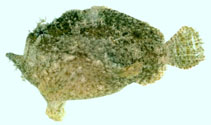| Family: |
Antennariidae (Frogfishes) |
| Max. size: |
14 cm TL (male/unsexed) |
| Environment: |
reef-associated; marine; depth range 0 - 10 m, non-migratory |
| Distribution: |
Indo-Pacific: East African coast, the Aldabra Islands, Cocos-Keeling, the Ryukyu Islands, throughout the Philippines and Moluccas to New Guinea and eastward to Tahiti. |
| Diagnosis: |
Dorsal spines (total): 3-3; Dorsal soft rays (total): 11-13; Anal spines: 0-0; Anal soft rays: 7-7. Coloration ranges from an ashy grey or light yellow to dark brown or even pitch black. On dark individuals, the median fins have pale edges. Bony part of illicium shorter than 2nd dorsal spine; esca oblong or tapering, usually directed ventrally.
Description: Characterized by having unbranched pelvic rays except posterior most bifurcate; second dorsal spine not connected to head by membrane and slightly curved posteriorly; gill opening on or adjacent to pectoral fin lobe; presence of caudal peduncle (Ref. 90102). |
| Biology: |
Found in intertidal reef flats (Ref. 1602). Oviparous. Eggs are bound in ribbon-like sheath or mass of gelatinous mucus called 'egg raft' or 'veil' (Ref. 6773). |
| IUCN Red List Status: |
Least Concern (LC); Date assessed: 06 September 2021 Ref. (130435)
|
| Threat to humans: |
harmless |
Source and more info: www.fishbase.org. For personal, classroom, and other internal use only. Not for publication.

